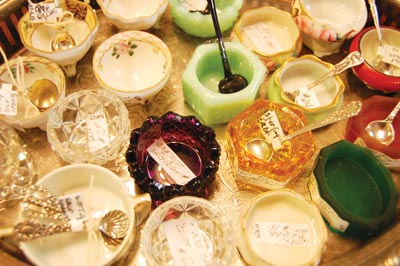Speaking of Antiquing – February 2015
One thing I’ve been collecting lately is tiny, multi- functional, elegant, practical, universal, and easy to afford—my growing collection of Salt Cellars, also known as salts, open dips, open salts, salt dish, or master salt.
The individual cellar would have typically been sterling silver, porcelain, glass, wood, ivory, pewter, or ceramic. Higher quality, of course, would be gold or enamel with gemstones and any number of intricacies.
Salt cellars have been on dining tables as a condiment holder for hundreds of years, if not thousands. It wasn’t until the Victorian era, in the latter part of the 1800s that salt shakers came in to fashion, replacing the salt dishes. Salt shakers made it easier for a hostess to set a table, allowing a shaker of salt and a matching pepper mill to be used by many guests rather than individual salt cellars.
American Glassmakers manufactured salt cellars in many shapes and colors, employing molds and designs that were pleasing and expressive. Many patterns from Sandwich Glass, Fenton, Candlewick, Anchor Hocking and others, are still widely available and very affordable.
The ones I enjoy most are hand-painted from Nippon (China) or Limoges (France). The Belleek (Ireland) are so thin and dainty that one would think that using them would break them. Many come with their own tiny spoon or “shovel.”
With the refinement of table manners, a tool for that purpose was employed in the form of a tiny spoon or “shovel,” eliminating using one’s fingers to pinch and scatter the salt. The shovels are typically made of glass, and are widely collected, as they are easily breakable and need to be replaced. The spoons were made of pewter, sterling silver, silver plate, wood, ivory, or porcelain. These are still widely-collected and highly-prized because tiny spoons are becoming harder to find. They can be ornate or plain, but always fun to use.
Many people who have salt cellars use them for catch-all’s on their window sills or vanities. “Smalls” such as rings or earrings can be stored in them. Some people use salt cellars on their table for mixing Wasabi for their Sushi, as they are just the right size.
There is a current craze in specialty salts from around the world. You might want to use your salt cellars and become familiar with new varieties of salt. You might find yourself giving both as gifts to your friends who haven’t yet discovered them.

 Margaret Barns is co-owner of Pickety Place Antiques & Collectibles located at 130 N. 4th Street in Jacksonville. LIKE them on
Margaret Barns is co-owner of Pickety Place Antiques & Collectibles located at 130 N. 4th Street in Jacksonville. LIKE them on
my wife’s mother had a collection of about 100 that we have on display in our home in Ashland